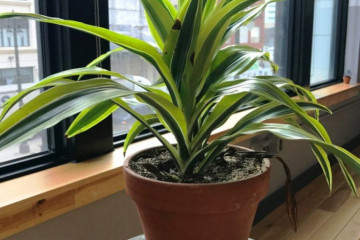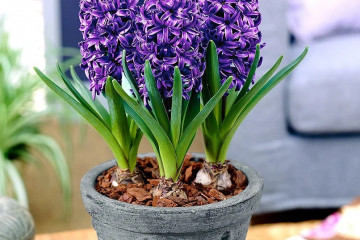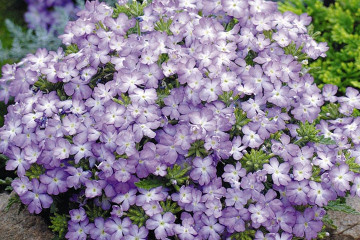Dracaena - home care and growing in a pot
Content:
Often in apartments and office premises you can find a beautiful, palm-like indoor dracaena flower.
The origin and appearance of dracaena
In their natural environment, there are about 160 species of trees or succulent shrubs of the genus Dracene. The distribution area covers tropical and subtropical forests of Africa, South America, Asia, and the Canary Islands. The plant belongs to the Asparagus family. Wild trees reach a height of 20 m.
The plant Dracaena got its name from the bright red color of the resin Dracaena Draco - one of its species growing in the Canary Islands. According to legend, the trees grew from the blood droplets of a slain dragon. Currently, 4 more species are known that secrete the same resin. Science explains the appearance of red droplets on the cracks in the trunk by the presence of a dark red gum in the resin.
"Dragon's blood" is used for medical purposes, lacquer is obtained from it for processing metal products, and is also used as a natural dye.
Dracaena leaves grow from the apical rosettes. The flowers open at night and have a pleasant scent.
Indoor dracaena grows up to 2 m in height and above. Indoors, she can live up to 15 years.
It is grown in apartments, summer gardens, greenhouses, and it often decorates the halls of hotels and restaurants. This is facilitated by the fact that caring for indoor dracaena usually does not cause problems.
Before purchasing a tree, you must immediately determine where the dracaena palm will grow, and how much space it can take. Depending on the conditions of detention, dwarf, compact or tall plants are selected.
Types of dracaena for indoor breeding
About 15 species of dracaena are grown indoors.
Dracaena Marginata
It is also called bordered. This is due to the fact that in this species, green leaves have a white or red edging. Dracaena Marginata was brought to Europe from about. Madagascar.
The indoor flower grows up to 3 m in height, so it is grown in tall and spacious rooms. Leaves are glossy, hard. The leaf plate reaches up to 0.8 m in length and 15 mm in width. Old leaves fall off on their own. Refers to narrow-leaved varieties.
The stem is thick, weakly branching. It clearly shows the attachment points of old fallen leaves.
Depending on the color of the leaves, dracaena are distinguished. Magenta, Bicolor, Tricolor.
Magenta leaves have a crimson edging, Bicolor has longitudinal pink stripes on them, Tricolor has tricolor leaves: narrow red and yellow stripes are located on a green background.
Dracaena draco
The second name is Canary dracaena. Indoors it grows up to 1.5 m. Leaves are grayish-green with clearly visible veins. The length of the leaf plate reaches 60 cm, the width is up to 30 mm. The tree is native to Ethiopia and the Canary Islands.
With sufficient light, the leaves take on a reddish tint.
The barrel is powerful.Has many shoots.
Dracaena Cordyline Australis
Grows wild in New Zealand on rocky slopes. In natural conditions, it reaches 7 m in height. The trunk of the tree practically does not branch.
The length of the leaf is up to 1 m. The color is bright green above and gray below. There may be a red border around the edge. The central vein of the leaf plate is orange or red in color.
Bush dracaena
Introduced to Europe from Africa. The leaves are uniformly green or striped. The bush species is one of the most hardy species of dracaena.
Deremskaya Varneki
The height of the tree is up to 2 m. The leaves are green, with a white longitudinal stripe in the middle and small light stripes scattered over the leaf blade. Flowers are white.
Deremskaya Bauzey
Just like Deremskaya Varneki, this variety has a white stripe in the center of the leaf, but, unlike it, has stripes of a dark green hue along the edges of the leaf.
The thick trunks of the deremsky dracaena are densely leafy.
D. Fragrans, or fragrant dracaena
The homeland of fragrant dracaena is Africa. The leaf reaches 65 cm in length and 10 cm in width. In the center of the leaf there is a longitudinal stripe of gray, yellow, yellow-green colors.
Dracaena flowers are small fragrant, have a pleasant aroma, collected in paniculate inflorescences. In indoor conditions, a tree can bloom once every 7-10 years.
The most common varieties are:
- Fragrant Knife. The plant has long dark green leaves with a narrow strip in the middle of a lighter shade.
- Fragrant Lindeny. The leaf is green with a yellow or white stripe along its edge.
- Fragrant Massange. Tall decorative tree. Has leaves up to 60 cm long. A wide strip is located in the center of the sheet plate. The crown is dense.
- Fragrant Rotiana. On the leaf plate, there is a narrow yellowish border on both sides.
- Fragrant Stednery. Tall variety. It has long, lanceolate leaves of bright green color with dark stripes.
Dracaena transplant into a pot
After purchase, the plant must be transplanted from the planting container into a flower pot. Also, dracaena is transplanted at a young age annually, an adult tree - once every 3-4 years. Transplanting is best done in the spring.
What is needed for landing
For transplant you will need:
- flower pot;
- priming;
- drainage material;
- gloves;
- water for irrigation;
- secateurs.
A flower pot is selected more than a planting container in such a way that it contains the entire root system and has a margin of 2-3 cm.The material from which the container is made does not matter.
Suitable soil is neutral soil, intended for growing palm trees, ficuses, etc. It can be purchased in a store or made independently from turf and leafy soil with the addition of sand and high peat.
Fine gravel, pieces of broken brick or expanded clay can be used as drainage.
Optimal location
For the normal development of an indoor flower, it is important to choose the right place for it.
The optimal conditions for dracaena during the growing season are as follows:
- Temperature - from +18 to + 22 ° С.
- Placement on east or south-east windowsills. You can install a flower pot at some distance from the south window.
- For the normal development of the plant, it is necessary to organize sufficient lighting. The tree loves diffused light, so it is necessary to exclude direct sunlight on the sheets. A plant with variegated leaves requires more light than a tree with monochromatic leaves.
- The selected location must be protected from drafts. Do not place the flower next to the air conditioner. You also need to exclude sharp fluctuations in ambient temperature.
Step-by-step planting process
Transplanting a dracaena plant is easy. It is important to strictly follow the sequence of steps.
Sequencing:
- Pour a thick layer of drainage into the prepared flower pot (up to 1 / 4-1 / 5 capacity).
- Pour some of the soil on top.
- Remove the plant from the container, examine the roots. Damaged or rotten - remove. Sprinkle the cut with crushed charcoal.
- If the plant has a normal appearance, does not get sick and develops normally, then the transplant is best done by the transshipment method, since this method is more gentle for the root system.
- Fill the remaining voids with soil.
- Water the soil abundantly with water.
- The second watering should be done after about 10 days. If the plant is sick after planting, a growth stimulant for the roots, for example, Kornevin (1 g of the drug per 1 liter of water), is added to the water for irrigation.
Dracaena reproduction
The tree is propagated using cuttings, air layers and seeds.
Cuttings
With this method of propagation, two types of cuttings are used: apical and stem. In the first case, the apical part of the shoot is 10-15 cm in size. The cut should be smooth.
Then it is placed in a glass of water. The water in the glass should be at room temperature. During the germination of roots, the water can become cloudy. In this case, it is replaced with a fresh one.
In addition, the stalk can be kept in a solution of growth stimulants Epin or Zircon before rooting.
You can also place the layers in a box with a prepared moist peat and sand substrate or with ready-made soil for palm trees.
The planted stalk is covered with a glass jar or plastic bag to create a mini greenhouse.
Periodically, the shelter is removed and the landing is aired.
When using stem cuttings, the shoot is cut into 5-20 cm pieces. Each piece should have 2-3 buds. It is buried 2-3 cm into the substrate or laid horizontally and covered with a layer of earth on top.
A mini-greenhouse is built over the cuttings. Rooting takes place within 1-1.5 months.
Growing from seeds
Planting material is purchased in stores or obtained independently.
Seeds are sown in a peat-sandy substrate to a depth of 0.5-1 cm and covered with glass or plastic wrap. The container for germination is kept at a temperature of + 25 ° C to + 30 ° C.
Seeds do not germinate well. Seedlings appear 1-3 months after planting. When the seedlings grow up to 4-5 cm, they are dived and planted in separate pots.
Dracaena care
For a houseplant dracaena, home care is simple. In order for the plant to develop normally, it is necessary to fulfill the basic agrotechnical requirements for growing a flower.
For the spring and summer period, a flower pot with a tree can be taken out to an open balcony, to a loggia or garden.
During this period, it is advisable not to allow the air temperature to be above 27 ° C.
Watering mode
Dracaena's home flower is a moisture-loving plant. Therefore, watering should be plentiful. Broad-leaved species require more watering than narrow-leaved species.
During the growing season, it is enough to water the flower once a day.
The tree does not react well to high concentrations of chlorine, fluorine and bromine in water and soil. Therefore, they take settled or rainwater for irrigation. If there is a lot of fluoride in tap water, it is filtered.
After watering, it is recommended to loosen the soil in the pot.
During the growing season, it is necessary to periodically wipe the leaves with a damp cloth. This will give a beautiful look to the flower and allow you to clean the leaf pores from dust. Also, 2 times a month, the plant is sprayed with warm water. Spraying is carried out in the morning or in the evening.
If you do not humidify the air, the ends of the leaves will turn yellow and dry. In addition, dry air is an ideal breeding ground for scale insects, spider mites and other pests. So spraying is also disease prevention.
Top dressing
It is carried out during the growing season. For her take complex fertilizers or mineral composition "Dracaena". The concentration of the working solution is carried out according to the instructions. Typically, the frequency of top dressing is once every 2 weeks.
During flowering
Indoor dracaena bloom very rarely. Young plants begin to bloom at the age of 8 to 11 years.
The flowers are small, white or yellowish in color, gathered in panicles. In fragrant dracaena, they have a sweetish delicate aroma; in other species, the smell may be unpleasant.
Caring for the flowering period is no different from caring for the plant during the growing season.
During the rest period
How to care for indoor dracaena in a pot at home during a dormant period? At this time, it is not recommended to place the flower near heating batteries, since the air in these places is hot and dry.
The optimal conditions for keeping a tree in winter are to maintain the air temperature at + 15 ° C and moderate watering (as the soil dries out). For variegated varieties, the temperature is slightly higher in winter.
Top dressing is carried out 1 time per month or not at all.
Preparing for winter
In order for the plant to prepare for the winter period, in the fall, the amount of watering is gradually reduced and the temperature is lowered. Also, the time interval between dressings is increased. During this period, nitrogenous fertilizers must be excluded so that they do not stimulate the growth of the green mass of the flower.
Dracaena is a very beautiful and spectacular plant that will perfectly fit into the interior of any room.
























